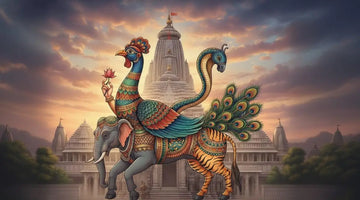Not many symbols in Indian mythology can convey the spiritual philosophy of unity in diversity as clearly as Navagunjara. It is a combined being consisting of nine different forms of life. In the religious terrain of Odisha, where divinity and art are perfectly intertwined, Navagunjara is the only one of its kind in Jagannath heritage.
Actually, Navagunjara is a representative of the inclusive vision of Lord Jagannath, a Lord of all beings, all faiths and all forms. Odisha temple arts, folklore and Pattachitra paintings are some of the media through which this symbol has been preserved for centuries and is still alive to impart the core of divinity as a balance and coexistence which is the essence of Jagannath mythology.
The Mythological Origin of Navagunjara
The story of Navagunjara is derived from the Mahabharata, when Lord Krishna, in a mystic mode, showed up before Arjuna as a hybrid being part peacock, bull, lion, elephant, serpent, deer, tiger, rooster, and human.
Each limb represented one aspect of the universe - love, bravery, wisdom, loveliness, strength and awareness - all six aspects were combined in one godly entity. It was not only a test of Arjuna's faith but a deep spiritual experience of lord Jagannath’s philosophy: that God is in every form, every being and every manifestation of life.
In the Jagannath heritage, the story turned into a metaphor for total acceptance. The very nature of Lord Jagannath - a god beyond caste, creed, and species - is the reflection of Navagunjara's message: God appears in different forms.
Uncover the fascinating story of the mythical creature Navagunjara from the Mahabharata and its symbolic wisdom.
Navagunjara in Jagannath Tradition: Symbolism and Significance
The twisted Navagunjara Jagannath myth goes deep with Puri's lore. Experts consider it the representation of Brahman the cosmic consciousness which is the root of all living beings.
The rituals of Jagannath temple, the deity’s rounded, abstract form without any human features is in line with Navagunjara’s composite identity from a philosophical point of view. Both names are pointing to the all-embracing spirit of inclusivity not to be singularity.
In Odia temple art, especially in the temple carvings of Puri and Konark one can see the subtle depiction of Navagunjara motifs together with Jagannath, Subhadra, and Balabhadra. These are not only the beautifications of the temples; they act as the visual sermons of unity lessons of living together and equilibrium.
Thus the link between Navagunjara and Jagannath is beyond the story and is the metaphysical representation. Both are bringing to the mind of the worshippers that the divine is not a single form but an endless range of forms and energies.
Dive into the spiritual and artistic depth of Navagunjara as depicted in Odisha’s timeless Pattachitra tradition.
Odia Temple Art: Where Philosophy Meets Aesthetics
Odisha’s art has been a conversation between those two elements that have been the base for its art, faith and form. Within this, temple art of odisha and Pattachitra paintings become the most emphatic vessels to convey the Navagunjara theme.
-
Pattachitra illustrations: In villages like Raghurajpur, master artists are still engaged in painting Navagunjara with natural pigments and intricate detailing. The creature is very often depicted as standing elegantly on one leg, thus conveying the idea of balance amid diversity.
-
Temples in Puri and Bhubaneswar, with their bas-reliefs, tell the story of the inclusion of composite creatures, thus revealing the blending of myth and geometry by the medieval artists with great finesse.
- The colors used in the painting have their meaning: Red stands for energy, white for purity, black for protection, and yellow for enlightenment thus pictorially reflecting the multifaceted divinity of Navagunjara.
The brushstroke or the carving is a revelation of the Odia perception of spirituality that art is worship, and diversity is divine order.
The Philosophical Connection: Lord Jagannath and the Cosmos

One needs to know the philosophy of Lord Jagannath himself in order to comprehend the Navagunjara in Jagannath tradition. Jagannath is not just a local god but a universal consciousness, a very subtle and abstract way of saying that all is one.
If Navagunjara fuses animal, human, and divine aspects to form one entity, Jagannath unites all religions, all living beings, and all the elements of the universe into one. The round eyes of the god signify being everywhere at once; his shapeless arms are a metaphor for the vastness of the created universe.
Both advocate the Advaitic (non-dual) perspective i.e. the distinctions between one’s self and the other, human and animal, are merged. That is the reason why Navagunjara is frequently spoken of in Jagannath lore as not being a different character but a divine incarnation of the Lord himself.
Navagunjara as a Cultural and Artistic Heritage of Odisha
The Navagunjara in Odisha is very much a real concept that permeates different aspects of life in Odisha such as textiles, murals, sculptures, and spiritual practices. The idea is everywhere in Odisha temple art, palm-leaf engravings, and even folk theater (Pala and Daskathia).
In Odisha’s Jagannath culture, the animal is a connection between human and divine the coexistence of intellect, instinct, and spirit as a single entity. Even its formation symbolizes the union of ecology and spirituality, in line with the Odia view that nature, art, and god are one and the same.
Still, the artists of Raghurajpur, Pipili, and Cuttack are tirelessly putting Navagunjara on their mythological hand-painted wall hangings, silver filigree work, and contemporary home décor through the art of the hand to keep the cultural conversation alive between the past and the present.
Explore how Navagunjara’s nine forms express harmony, coexistence, and the beauty of diversity in Indian art.
A Modern Interpretation: Relevance of Navagunjara Today
Navagunjara Jagannath, a culturally diffused world today, is a metaphor that is beyond time for inclusion and unity. Its message is not confined to religion but goes to mankind teaching that harmony is not found in being the same but in acceptance.
- Social harmony: As the Navagunjara merges the contrasts to make them equal, the society becomes viable when different viewpoints exist together.
-
Ecological harmony: Every figure of Navagunjara is an elemental of nature giving a call to us to respect biodiversity and be dependent on each other.
- Individual development: On a spiritual level, it signifies the inner fusion the balancing of power, love, reason, and insight.
The Jagannath heritage is like a museum of this symbolism through festivals, art, and narrative, thus making Odisha a living icon of the co-existence of the faith.
See how contemporary artisans bring ancient mythology to life through detailed, hand-painted Navagunjara art pieces.
Maavni: Keeping Odisha’s Spiritual Art Alive
Maavni is keeping the eternal story of Navagunjara in Jagannath tradition alive and well, and it continues to be a source of inspiration for contemporary artists. The original philosophy of unity and divinity of Odisha, which is more than just art, is present in every made-by-hand Navagunjara wall plate, idol, or decorative item.
The mission of Maavni is not just about beautifying space. By engaging in a direct relationship with the artisans, the brand is not only preserving the traditions of temple arts of odisha but is also taking them to contemporary homes. Each artifact is a celebration of Navagunjara Jagannath, not as one of the mythologies that have been frozen in time, but as a living philosophy - the one that resonates with inclusiveness, mindfulness, and aesthetic appeal.
The essence of Jagannath's harmony is thus able to enter the homes of people all over the world through Maavni’s carefully planned collections, thereby turning the artistry and beauty of the décor into an act of preservation and devotion.
Key Takeaways
-
Navagunjara Jagannath is the union of nine creatures, thus signifying universal harmony and the all-inclusive nature of divinity.
-
The story is from the Mahabharata but is most deeply associated with Jagannath mythology and Odia spirituality.
-
The Odia temple mural and Pattachitra painting are the media that celebrate this metaphor through their colorful and imaginative narratives.
-
Navagunjara is a perfect representation of the Jagannath tradition the diversity is the divine law.
-
Maavni keeps this heritage alive through the exquisite handcrafted pieces, a perfect mix of age-old charm and modern sophistication, thereby making the mythology of Odisha relevant to the contemporary milieu.
Conclusion
Navagunjara Jagannath, in the sacred realm of Puri where even the tiniest detail seems to be a tale, is telling us that the most divine thing is to be complete - to recognize every form, every voice, and every spirit as one. This universal theme of coexistence is still being lit up by the skilled craftsmen of Odisha and the creative energy of the brands like Maavni, to be forever there, outer and deeply human.
FAQs on Navagunjara’s Connection with Lord Jagannath
1. What is the story behind Navagunjara?
Navagunjara appears in the Mahabharata, where Lord Krishna takes the form of a creature made of nine animals to teach Arjuna that divinity exists in every being. It symbolizes harmony and the unity of all life forms.
2. How is Navagunjara related to Lord Krishna?
Navagunjara is seen as one of Krishna’s divine forms. It reminds us that God transcends all shapes and species a belief that aligns deeply with Lord Jagannath’s inclusive vision as the “Lord of All Beings.”
3. What does the rooster symbolize in Navagunjara?
The rooster stands for awareness and spiritual awakening. It signifies the call to realize the divine unity present in all creation.
4. Who created the Navagunjara?
The legend originates from the Mahabharata, but Odia artists and temple sculptors gave it lasting form through carvings and Pattachitra paintings, preserving it as a key symbol of Jagannath culture.
5. How is Navagunjara connected to the Jagannath Temple in Puri?
A carving on the temple’s northern wall shows Arjuna bowing before Navagunjara. The Neela Chakra atop the temple also bears eight Navagunjaras, reflecting the Lord’s all-seeing and inclusive nature.
6. Why is Navagunjara depicted on the Neela Chakra?
The eight Navagunjaras on the Neela Chakra’s rim represent divine presence in all directions, echoing the Jagannath belief that God exists in every form and being.
7. What is the link between Navagunjara and Pattachitra art?
Navagunjara is a popular theme in Pattachitra paintings, often shown in vibrant natural colors. It highlights Odisha’s spiritual idea of unity through diversity, deeply tied to Lord Jagannath’s philosophy.






